AN UNKNOWN EPISODE IN THE
HISTORY OF THE RESISTANCE
translated by W J Pryer
from French newspaper articles written by L-J Grangé which appeared in
La Republique du Centre 10, 12, 17, 19 Aug 1966
and also Echo du Centre 22 June 1967 and Le Figaro
Some editing by Frank Haslam 2002, updated 1 July 2004
Please note that many of
the images are of poor quality in the original newspapers.
If better quality images are available please contact the editor Frank
Haslam
INTRODUCTION
Having collected information from those who took part in this incredible adventure and having seen photographic evidence about that life of the "Men of the Woods", it is the intention in the following account to make known one of the most extraordinary episodes of the last war.
The silence which those responsible for the camps had to respect for ten years, and the modesty of the many members of the Resistance in Eure-et-Loir and Loir-et-Cher who participated have prevented until now the telling of this unique feat in the annals of war.
It was unique in many respects. More than 150 Allied airmen - Americans, English, Canadians, South Africans, New Zealanders and Belgians - lived in well organised camps, in the middle of Occupied France, in the Forest of Fréteval, between Cloyes and Vendôme, and that for several months under the very noses of the occupying troops. These airmen, whose planes had been shot down over enemy occupied territory, added up to 14 Fighter Squadrons [translator: in fact they were mostly from Bomber Squadrons].
Unique, too, was the fact that this operation, which entailed bringing together many members of the Resistance, remained absolutely secret to the point that the inhabitants of the villages surrounding the forest were unaware, until the end, of the existence of that allied force so close to them.
Unique lastly, and how comforting to those responsible, because over the months which passed by until the happy outcome of the operation, not a single human life had been lost either in the ranks of the Resistance or in those of the Allied airmen.
At a time when bitter controversy has been aroused by the publication in Great Britain of the book 'S.O.E. in France' by M R D Foot, about the activity of the British Secret Service [sic] in France between 1940 and 1945, this episode shows that, thanks to the co-operation between that Secret Service, the RAF - British material - and the French Resistance, airmen were picked up, escorted, fed and cared for before taking, after the Liberation, their place once more in the fighting forces. Most certainly, this was a precious contribution to final victory.
The success of the operation, which brought its own reward through collective effort inspired by patriotic and humanitarian impulse, deserves to be known.
I. HOW TO RETURN TO ENGLAND BRITISH AIRMEN WHOSE PLANES HAD BEEN SHOT DOWN
Throughout the war and especially from 1941 when Allied raids over occupied territories and Germany began to intensify, a great anxiety of the Military Staff was to be able to recover those indispensable specialists, the allied airmen whose planes had been shot down in the course of operations. These men had to escape by all means possible from enemy search, hide themselves, then try and get in touch with the Resistance in order to regain England.
A special service called MI 9 was created under the wing of the Intelligence Service, with the object of organising, conjointly with the local Resistance of the different countries and intermediaries sent from England, lines of evasion and repatriation towards the British Isles.
The one named "Comet" was the most important and succeeded in putting back hundreds of airmen into the fight. One of the organisers, Baron Jean de Blommaert, living today near Brussels, entered the clandestine movement in 1940. Never caught, he operated under several false names and earned from the Germans the nickname of "The Fox".
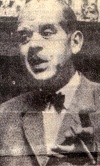
The Belgian Baron Jean de Blommaert
The means of repatriating the airmen was as follows. They were first collected by the local inhabitants, who by doing so took enormous risks. Thanks to the network of information built up, members of "Comet" then took over the "parcels" (as the recovered airmen were referred to), transporting them to centres such as Liege, Brussels, Lille and Reims. The men were then regrouped in the Paris area, before being conducted to the Spanish frontier, which special guides enabled them to cross. Finally, they reached Gibraltar or Lisbon, whence transport aircraft of the RAF repatriated them to Great Britain.
These dangerous movements were carried out mostly by rail, and conducted by devoted French and Belgian guides. Many paid with their liberty and often with their lives for the precious aid they gave to the airmen.
However, in January 1944, when the date and location of the invasion was known to those entitled, MI 9 found itself faced by a number of problems. It was obvious that attacks were going to be concentrated on lines of communication in Occupied France, disorganising the railways completely and thereby interfering with the transport of airmen towards the Spanish frontier. Furthermore, the Resistance members who formed the core of the guides would at that time have other vital tasks to accomplish.
Because the Allied air forces were to expand their operations over France, Belgium and Germany, it became necessary to reinforce the evasion network and to install a series of relay camps in zones dominated by the "Maquis", from which the fugitives could be led towards Britanny and from there to Great Britain by boat.
This plan was about to be put into operation, when on 13th May [1944] M. Lucien Boussa, today a retired colonel at Rotheux-Rimière, Belgium, then a Squadron Leader in the Belgian unit of the RAF, arrived at the Resistance headquarters.
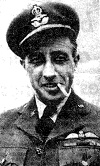 |
Lucien Boussa in England at the end of 1943 before his departure for France. [He was promoted to Wing Commander for his part in this affair] |
Speaking French and perfectly acquainted with all that concerned the RAF, he was well qualified to uncover any doubtful elements which could have infiltrated into lines of evasion and wrecked prearranged plans. Following three months' special training, he had left England with his radio operator, François Toussaint, from an airfield near London and by a devious route had reached Paris. The invasion being imminent, there was no time to lose.
II. THE CHOICE OF THE FOREST OF FRÉTEVAL AND THE SETTING UP OF THE CAMPS
M. Boussa had left England. and had arrived in Paris carrying an urgent counter-order from the British Secret Service:
"The invasion is near. No longer evacuate airmen. Hide them where they are".
He then met J. de Blommaert and it was decided to set up, relatively close to the place decided for the invasion, one or more camps in a forest area, which would serve as terminal points for the different escape lines.
The chosen site had to be fairly near the areas which were going to be subject to intensive bombardment (i.e. Normandy) and where very probably losses in aircrew would be heavy. The relative closeness of the invasion beaches allowed, moreover, the hope that the liberation of the camps by advancing Allied troops would be effected with the shortest delay, thus reducing the risks.
The region chosen for setting up the camp was therefore determined by a triangle defined by the towns of Vendôme, Le Mans and Chartres. Through the intermediary of members of the Comet Line, M. Boussa was able to get in touch with "Sinclair" (M. Maurice Clavel, an author), a young man who had just taken over the departmental command of Eure-et-Loir for the French Forces of the Interior. Not yet conscious of all the possibilities afforded by the Resistance groups placed under his orders, "Sinclair" sought the advice of members of the Office for Aerial Operations (M. Gagnon) and of the Liberation Movement (MM. Poitevin and Dufour).
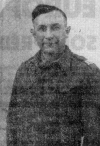
Captain Jubault, of the
95th RI, after the Liberation
About then, "André" (M. Omer Jubault), a gendarme from the Cloyes brigade, joined the clandestine movement. With the help of a colleague (M. Hackspille) and of M. Paulsen, manager of a factory in Châteaudun, he had succeeded in creating an important Resistance group. Contacted at Beauvilliers, he immediately accepted the responsibility in his sector of harbouring Allied airmen as being of higher priority than carrying out harassing actions against the enemy. Acquainted perfectly with the region and its inhabitants, he was nonetheless going to assume a heavy responsibility in carrying out a plan requiring the utmost devotion.
But Why the Forest of Fréteval?
M. Jubault, who has in his possession an important record of the operation, containing for example many testimonies recorded on magnetic tape lasting seven hours, explained the situation to us.
"Foreseeing the operations which my group would be called upon to do at the time of the Liberation, I had set up different sites in the woods, having sources of drinking water, hiding places for arms, etc., which could constitute "maquis" for my forces."
"In the Forest of Fréteval", M. Jubault told us, "the Germans had set up small munition depots over several miles in the undergrowth bordering the forest paths, amounting in all to one or two lorry loads. In order best to keep watch and to supplement guard posts installed in two forest huts, patrols covered the forest paths day and night. In addition, every so often, beats were organised in the forest by the officers of the Field Command at Vendôme for hunting big game."
"However in the depths of the thick undergrowth where the enemy sentries did not venture, it was possible to hide the airmen without the protection of arms, so long as one essential was respected ...to make as little noise as possible. The presence of the German troops kept away the curious. Situated on the border between the two departments, Eure-et-Loir and Loir-et-Cher, the site seemed just right."
The Installation
That was why on 18th May, a little group consisting of M. Boussa, his radio operator, "Sinclair" and Jubault, accompanied by three companions left Châteaudun by bicycle and set out towards the Forest of Fréteval.
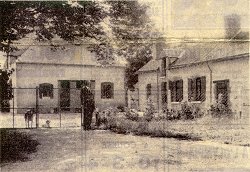
The forester's house, Bellande:
it served as cover for the headquarters of the camp
When they arrived at a place called Bellande, in the commune of Villebout, M. Jubault showed the site which he had studied. The Allied officer accepted it on the spot. The relatively clumpy forest would hide all activity going on behind its foliage. A spring of pure water bubbled up scarcely a hundred yards from the centre of the place selected for the camp.

M. and Mme Hallouin. In the centre of activity
at Bellande, they harboured Colonel Boussa.
Concealed by a ring of trees remote from the road was the house of the forester, M. Hallouin, in the service of the Marquis of Levis-Mirepoix. It was in just the place for making it the temporary residence of Colonel Boussa, chief of the future camp. He and M. Hallouin only occupied part of the dwelling. An adjoining farm would permit the storage of foodstuffs. The radio operator, for reasons of elementary security, was taken 15 km away to a doctor's house at Moulineuf, in the commune of Romilly-sur-Aigre, where he could transmit. Liaison would be ensured by M. Jubault's two young children.
After the arrival of the Allied officer, the escape route, through escorts selected for the purpose, brought the first airmen. These were two Canadians. They put up the first tent of what in a few days was going to become a curious canvas village. Operation "Sherwood" (from the name given to the forest in Nottinghamshire which served as the refuge for Robin Hood) had begun.
The Difficulties
To understand the risks run by the Resistance, let us recall that each week red notices with black letters announced, by way of example, new executions. On the 30th March 1944, 31 Resistance members of Eure-et-Loir had been put to death at Mont-Valérien.
What is so difficult to imagine for those who never knew this period was what life in France was like at the beginning of 1944. How to eat, to keep warm, to dress and to move about - in a word, every item of daily life posed at each moment insoluble problems.
One detail which has been reported is illustrative. In an area of more than 10,000 inhabitants, the authorities had only seven balls of working clothes to distribute over two months. Even more difficult was that the clothes were of very poor blue and all sorts of sizes. Everything was rationed and in clearly insufficient quantities bread, milk, sugar, meat, fats, dough and flour. There was no longer any coffee, rice or chocolate. Wine was distributed only very parsimoniously.
Nothing to burn, no petrol and no rubber. Imagine then the difficulties brought about by the reception of an unknown evader, a fugitive unable to speak French. An airman falling by chance into the charge of an isolated person without the slightest notion of the Resistance network, which itself had only few means and prey to worse uncertainties. The patriots were reaching the point of being no longer able to feed their guests.
At first the airmen arrived at Châteaudun station, usually escorted by brave women guides. From a relay set up in a little grocer's shop in the rue de la Madeleine, they had to be taken by devious ways to the outskirts of Cloyes. M. D. Cogneau, a physical culture instructor at Châteaudun high school, accepted the responsibility of escorting them. He accomplished this task without interruption for three months with members of his family.
He was helped in his task by MM. Serein, L. Bezault, P,. Poupard, A. Méret and his children, and by L. Thibault, as well as many others from Châteaudun, Courtalain, St-Jean-Froidmentel, Moree, Montigny-le-Gannelon and Cloyes, whom we must be excused for being unable to cite; also from Combres and Chassant where M. and Mme Bacchi offered temporary sanctuary.
So as to outwit the watch kept up by the enemy, the escort, route and means of travel had constantly to be changed. All ways were used: on foot the most often, by bicycle, car, and horse and cart, especially after the destruction of the railways. From that time on, the airmen were brought on foot from Dourdin. Gaston Duneau, a mechanic of Montboissier, went and fetched them in little groups of one to five men from a farmer's [undoubtedly M.Leroy, translator] at Sazeray, near Voves.
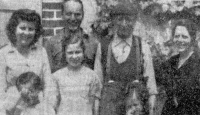 Gaston Duneau and his family, with W Pryer one of the many aviators he helped |
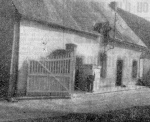 La Ferme de Sazeray, near Voves, a link in the Comet Line |
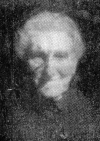 Mme Leroy, widow: she sheltered more than 100 aviators on her de Sazeray farm |
Equipped with implements pitchforks, hoes, etc. so as to look like farm labourers, they were lead along little frequented ways and always by day, at times walking across the fields. So it was that this patriot sheltered in his home 53 evaders, for the most part Americans and British. From Montboissier, the airmen were directed to Chenelong, in the commune of Gohory. Here the Châteaudun escorts took over for traversing, as painlessly as possible for these tired men, the last 15 kilometres.
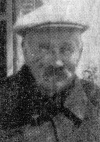 M. Paul Fougères of Chenelong, Commune de Gohory. His house was the last link on the way to the camp |
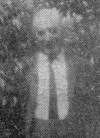 M. Guet who was a cultivateur aux Audrieres, he received the first aviators. His hospitality was well known among the Resistance |
While awaiting the setting up of the first camp, the airmen were harboured with patriots of the region (Cloyes, Saint-Hilairesur-Yerre, Langey, St-Jean-Froidmentel, Morée). These, as we have already said, knew the dangers which threatened them. Indeed, 14 inhabitants of Vendôme had just been deported for having sheltered the crew of an Allied aircraft. The incident made the Resistance proceed with great caution and certainly this was a determining factor in the successful outcome of the enterprise.
From the start, Colonel Boussa, seeing the magnitude which the operation was going to assume, appealed to Jean de Blommaert. The latter came to rejoin him and together they buckled themselves to the task.
III. HOW THE AIRMEN LIVED IN THE FOREST CAMPS
From the start, the mass arrival of the airmen posed very many problems. It was necessary to put up tents of all sorts provided by various people contacted by the Resistance. Provisions had to be found, food obtained and also tobacco, for the men's morale.
Happily, as regards food, M. Jubault, with the possibility in mind of creating a local "maquis", had already obtained the collaboration of a miller (M. Ciron) [actually M. Viron] for providing flour to bakers at Fontaine-Raoul, St-Jean-Froidmentel, Busloup and Romilly-sur-Aigre. Meat, milk, butter and eggs came from farms situated within 30 km radius of the camp. Animals, etc., were mostly brought live by Resistance drovers to a farm neighbouring the forest.
However, to keep pace with the growing needs, it often became necessary to go long distances across country before finding a farmer who would consent to sell a piece of meat or a pound of butter. "Fishing parties" had to be improvised at night on the banks of the Loir at Montigny.
After some twelve days, about fifteen tents were already up and life began to take shape among the tenants of this very special village. Three sentries kept watch over the immediate approaches, with recourse to a simple alarm system in case unidentified persons approached.
Cooks were improvised and, thanks to very quickly gained experience, soon became veritable "chefs". The stoves, fed with charcoal so as to eliminate any tell-tale smoke, were barely noticeable. Various "fatigues", inherent in all communal military life, were organised and accepted with good humour.

The stoves and kitchen.
A most important point was the arrangement of the tents and their approaches. Although the camp, situated in the middle of the forest was difficult enough to detect from the ground, it was by contrast visible to aircraft flying over the region. With this possibility in mind, Allied aircraft would be as dangerous as German ones. It was absolutely vital that every morning the tents were covered with fresh boughs. Tables and benches were made out of tree trunks and branches.

Tents and allied airmen
Free time was taken by each according to his fancy. Some preferred the comfort of their tent, others carved wood. When the weather was good, the airmen tried to find a sunny corner. To provide some comfort to the inhabitants of the camp, M. Barillet, a barber of Cloyes, came once a week to exercise his art.
Extraordinary reunions took place. Almost complete crews were assembled bit by bit with new arrivals. Such moments were always joyfully celebrated, especially when it had been believed that certain comrades had died.
Creation of a Second Camp
The invasion in Normandy took place and with it the number of airmen arriving at Bellande increased. It soon became evident that an increase in the size of the camp, which at that time contained more than 25 tents, would be too big a risk to take. It was therefore decided to create a new centre of refuge 10 km away, at a place called Richeray, in the commune of Busloup.
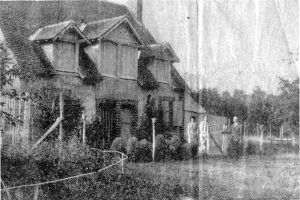
M. Rideau and his daughter, Micheline, with M. Jubault, in front of
the
forest house of Richeray. Two hundred yards away, hidden in the
foliage, was Camp No. 2.
Jean de Blommaert took command of it. He organised it on the model of the first, with which he remained in permanent contact. It, too, had a nearby spring and forest house. The forest ranger, M. Rideau and his wife (who has recently died) helped by M. Avrain, daily took part in providing for the airmen.
Despite the Germans being very close, no incident occurred. It was true that the requirements of peace and quiet were particularly severe. There was to be no trying to get to England by their own means and there had to be as little noise as possible. On calm days with no wind, the airmen spoke to each other in whispers. To raise a voice ever so little ran a fatal risk.
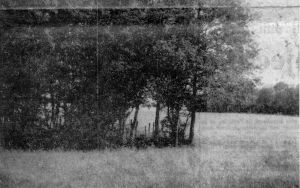
In a corner of the wood: the spring hidden in the trees
A Canadian tells of his life as a "Man of the Woods":
"Some days", wrote W. Brayley, a Canadian now director of a pharmaceuticals firm and who kept up a sort of diary on his stay in the camp, "you only heard a few whistles when the sentries gave notice of the arrival of new companions". Because he spoke French, he was one of those whom M. Rideau led at night for taking delivery of provisions destined for Camp No. 2. They had first to go five km through woods and fields, then by road.
W. Brayley tells us how at night his companions and he made raids on German munition dumps. "We succeeding in taking a great quantity of grenades and several cases of ammunition which we went and dispersed in the bushes."
On 14th June, they got hold of a radio set, the receiver being installed in the camp itself. "Every time messages or important information was obtained, a bulletin was pinned on a tree serving as a notice board. This central spot was known as Hyde Park Corner, from which radiated paths christened with the names of well known London streets."
Mr. W. Brayley also noted: "One very welcome message was when a voice announced "The Eiffel Tower is leaning to the right", meaning that a parachuting would take place the following night. But it happened that the aeroplane passed several times over the landing ground without discharging its cargo. The morale of the men went went down."
By contrast, on 7th July: "Some beautiful black Halifax bombers roared over our heads. The bomb doors opened; fifteen white parachutes fell and hung over a cornfield. We ran towards the containers filled with medical supplies, food, underclothing and money, all very important things in the circumstances. We worked feverishly until dawn.
After the parachuting, men went and put upright the stooks of corn knocked down by the containers, so removing all trace of the operation. In the course of the day, the parachutes were converted into sheets and thread from the ropes was used for articles of needlework".

Sorting containers of supplies dropped by parachute
[on right, Thomas Yankus, Radio Operator, B17G OE-U 42-31565, 335th
BS, 95th BG,
crashed 4 Mar 44 at St-Symphonien near Mons, Belgium]
On 11th July, a golf club was started. The clubs and balls were fashioned out of wood. Tournaments were organised.
But on 18th July, the peace of the camp came to a sudden end. A German patrol stopped a group of the Resistance men. "The Germans remained ignorant that allied airmen were hidden in the forest, although they were aware that something was going on. They never ventured into the woods to find out. Instead, the patrols contented themselves with machine gunning the forest paths at intervals. We were continually on the qui-vive but no one was wounded.
IV. TO THE LIBERATION
The Wounded and Ill
Among the airmen who arrived were the wounded, especially those suffering from burns. Members of the Resistance sheltered and cared for them. At Villebout, for instance, a widow, Mme Després, an octagenarian very active for her age and able to speak perfect English, set up in her premises of Clabaudières a veritable hospital, visited every day by two doctors, M. Teyssier and his son.
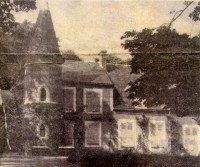
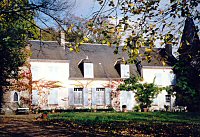
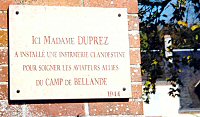
The manor of Clabaudières at Villebout. Secret hospital. 'Then' and
now (recent: Emmanuel Krafft)
In the camps, "ambulance" tents were erected where the ill and wounded could be looked after by airmen having some idea of hospital work. Dr. Teyssier came regularly to give treatment and have evacuated to the secret hospital those whom he considered would be better in bed.
Welcoming New Arrivals
Except for the doctors and the barber, very few people were authorised to enter the camps. The reception of new arrivals was held a kilometre away from the first camp by a welcoming committee consisting of several existing residents, one of whom, a man of unusual height, was equipped with an enormous cudgel. These submitted the new arrivals to a complete interrogation which no enemy agent would have been able to answer without becoming confused.
Fortunately, the cudgel was never used.
Incidents
However incidents and set backs were not lacking. One, had it not been for the coolness of the woman escort, who swallowed a compromising document showing the local "maquis" a route to follow and the site of Camp No. 1, could have wrecked the whole operation.
The escort, Mme Virginia d'Albert Lake, an American by birth, belonged like her husband Philippe, to the Comet network. She was riding her bicycle 150 yards in front of a cart in which were hidden five airmen, when she was unexpectedly intercepted by German police. Vigilant, the driver of the cart immediately alerted the five men, who jumped off and took flight without being seen by the Germans. They reached the camp later after much wandering.
Meanwhile, Mme d'Albert Lake, whose accent betrayed her origin, was arrested and from one concentration camp to another she finished up at Ravensbruck where she nearly died of starvation. She paid with her liberty for the work she did on behalf of the airmen. The latter will always owe "Virginie" a debt of gratitude.
Once this arrest became known, the camp was alerted and the airmen got ready to flee to prearranged meeting places. Mme Hallouin prepared a big fire in the chimney which she was going to light if the Germans arrived. The smoke which would have been emitted would have been a convenient signal for indicating danger.
Before that, MM. Jubault and Jean de Blommaert had been questioned by an enemy patrol. It was their assumed ease which saved them.
The HQ at St-Jean-Froidmentel Railway Station
During the first half of July, as extra security and because of the amount of traffic at the farm of Bellande in provisioning the camps, Colonel Boussa decided on the advice of M. Jubault to install his command post in the station of Saint-Jean-Froidmentel. From there he directed his messages, which were then transmitted to London by his radio operator.
The functions of station master were carried out by Mme Demoulière, whose husband had been badly wounded in the 1914-1918 war. These two had already several times welcomed and sheltered airmen before passing them on to the evasion lines.
The station of Saint-Jean-Froidmentel, on the line from Paris to Vendome, was at that time much frequented by people coming to get food in the surrounding countryside. It resulted in continual coming-and-going, which masked well the comings-and-goings created by the command post of the Allied officer. The danger, however, was great, for on the other side of the railway the Germans occupied the chateau of Rougemont.
Liaison between the H.Q. and the camps in the forest was ensured by M. P. Guillaumin ("Gilbert"), M. Jubault's close assistant. He was entrusted among other things with feeding and escorting airmen picked up in the locality by the Franc-Tireur and French Partisan movement. Members of this group, notably A. Lhuillery, C. Sandre, G. Fortière and P. Fenin had been shot at Cormainville after having been horribly maltreated. Another, Jehanneau, known as "Kid", brought about twenty airmen to the station of Saint-Jean-Froidmentel. Four of these had been picked up in the middle of the night in blinding rain in the neighbourhood of the commune of Conie-Molitard.
The radio operator, for his part, several times changed his place of refuge for security reasons.
Liberation
For everyone, the waiting was long. Radio communiques continued to indicate the advance of the Allied troops, but they waited in vain in the region of Cloyes. Impatience mounted. Retreating German troops began to trek along the roads. The airmen had no arms; this decision had been taken at the creation of the camp in order to prevent as far as possible any tragic consequence in case of arrest. To ensure safety, Colonel Boussa requested the Resistance to provide small armed detachments. This was done but they never had to intervene.
By the beginning of August, there was no doubt about the Liberation. Colonel Boussa, having learned that the Allied front line was progressing as far as Le Mans, 70 km away, decided to go there to urge haste in recovering the airmen. M. Viron drove him in his car. They passed by German troops in complete disorder in reaching the American soldiers to the east of the town. At the headquarters, Colonel Boussa met M. Neave, the representative of MI 9, whom he had left some months before in England. It was then decided that on 13th August a column under British command would go and find the lodgers in the forest.
The extraordinary adventure of the airmen came to an end. On 12th August, they went in groups to Busloup and Saint-Jean-Froidmentel. Despite the last of the Germans still passing by, the inhabitants found themselves surrounded by young men speaking English. Soon flags were unfurled and, to celebrate the end of their nightmare, the villagers hastened to get out from their cellars bottles of "fine", preciously guarded for this very occasion.
The next day, 13th August, the expected column arrived. It was not without emotion and perhaps with a certain regret that the airmen threw a last glance over that great forest which had sheltered them for long months. Several members of the Resistance advised of the departure came to say goodbye.
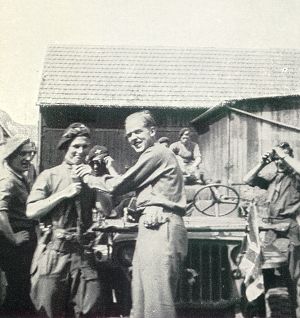
Jean de Blommaert (centre) at the liberation of the Fôret de
Fréteval camps 1944 (Neave)
To the very last moment, luck had smiled on the escapers. All took up again their flying service. In what was to follow thirty-eight of them were going to lose their lives in air operations over Germany.
The fact of being able to bring more than one hundred and fifty airmen to the Forest of Fréteval, and to hide and feed them there, constituted a "tour de force" by the local resistance. But that all those men could have lived from May to August in that region open to constant patrolling by the German occupying forces remains inexplicable.
At the end of our investigation, we thanked Colonel Boussa, M. Jubault and others for having furnished us with documents on this wonderful page in the story of the Resistance. In respect to the spirit which animated it, we have tried to retain the essentials of this extraordinary and almost unbelievable adventure, of which certain actors unfortunately have already disappeared.
It has been impossible. in this short account, to cite the names of all those who picked up, harboured, hid, clothed, fed and escorted the airmen. Besides, because these events took place in secrecy, certain participants remain unknown. But all well merit the recognition of the airmen whom they helped to save.
L. J. Grangé
July 1966
[Editor] In order to commemorate this episode, at the request of many people, a committee was set up with the object of setting up a Memorial beside the road leading from Cloyes towards La Ville-aux-Clercs, the site of Camp No.1.
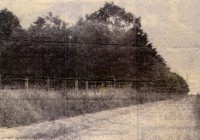
The memorial site
In order to cover the necessary expenses, the Committee asked those interested in the scheme to address their contributions, however modest, to the Treasurer, Committee for the Memorial to Allied Airmen Picked up by the Resistance.
These four articles, written by L. J. Grangé of Bonneval, were published in La Republique du Centre, issues of the 10th, 12th, 17th and 19th August, 1966. (Translated by W.R. Pryer, with selections from the translation by the girls of Bishop Fox Grammar School, Taunton.)
Additional information: Philippe Save